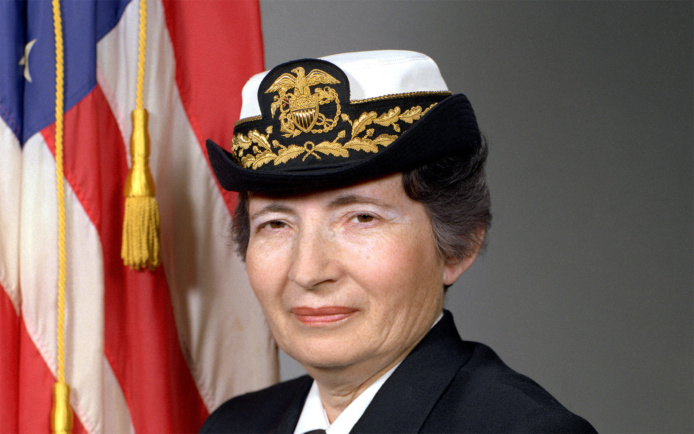Faye Glenn Abdellah became a nurse in 1942 and a living legend in 1994
This story appears in the October 2025 edition of The Washington Nurse.


What inspired you to become a nurse? Perhaps you were inspired by a family member or friend, or experienced or cared for a loved one with a chronic or terminal illness.
Faye Glenn Abdellah (1919-2017) knew she had to become a nurse when she witnessed the aftermath of the 1937 Hindenburg aircraft explosion, which occurred near her home in Lakehurst, New Jersey. She was 18 when she and her brother rushed to help the victims.
In a 2004 interview in Military Medicine, she remarked, “I could only view the tragedy of the poor scorched victims exiting the dirigible. It was then that I decided that I would never again be powerless to assist when people were in so dire a need. It was at that moment that I thought that I’ve got to do something. I’ve got to become a nurse.”
Want to know more about the Hindenburg disaster?
Abdellah, EdD, LLD, ScD, RN, FAAN, went on to graduate from New Jersey's Ann May School of Nursing in 1942, and later earned her doctorate from Columbia University in New York City. Her work has had an outsized impact on the nursing profession by taking a holistic approach to patient care and moving nursing from task oriented to a profession.
Abdellah did more than just become a nurse. She became the first nurse officer to earn the ranking of two-star rear admiral and the first nurse and first woman in the 200-year history of the United States Public Health Service to serve as Deputy Surgeon General (1981-1989). A Korean War veteran, she received five Distinguished Service medals and the Surgeon General’s Medallion in 1989 for her professionalism and exemplary service.
She was also the founding dean of the Uniformed Services University of the Health Sciences Daniel K. Inouye Graduate School of Nursing in Bethesda, Maryland. In 1994, she was named a living legend at the American Academy of Nursing. In 2012, she was inducted into the American Nurses Association Hall of Fame.
21 Nursing Problems Theory
Abdellah pioneered the 21 Nursing Problems Theory, from which she developed the Patient Assessment of Care Evaluation that is still the standard used in the United States.
The 21 Nursing Problems Theory emphasizes the physical, emotional, and social needs of patients, rather than just the illness itself. The theory helped to shift nursing from task-oriented to patient-centered, and from a service to a profession. This theory forms the foundation of nursing assessment, care, and treatment of patients in a human-needs centered way. This model was progressive for its time, as it refers to nursing diagnoses when nurses were taught that diagnosing was not part of their role in healthcare.
Progressive-care units
Abdellah spent most of her career in the Public Health Service and academia. In 1957, she led a research team that established the groundwork for progressive-patient-care units. As part of that work, she developed the first nationally tested coronary care unit.
She was one of the first people to develop a classification system for patient-oriented records, and her work was foundational in developing the diagnostic related groups (DRGs), which is the standard coding system used by Medicare.
Abdellah retired from the Public Health Service in 1989. Shortly after, she founded and served as the first dean in the Graduate School of Nursing in the Uniformed Services University of the Health Sciences. This school, dedicated to educating graduate nurses from military services, is fully accredited and offers one MSN degree, one PhD program, and one DNP degree with five advanced practice nursing specialties: Nurse Practitioner (Family Nurse Practitioner, Psych Mental Health Nurse Practitioner, Women's Health Nurse Practitioner), Adult Gerontology Clinical Nurse Specialist, and Registered Nurse Anesthesia.
About the 21 Nursing Problems Theory
The 21 Nursing Problems Framework addresses the multifaced needs of patients divided into three distinct areas: physical, sociological, and emotional needs. Each category includes specific issues related to patient care, and when taken together fashions a holistic approach to nursing practice, education, and research.
The 21 Nursing Problems are listed below:
Basic care — four needs directly impacting a patient’s physical health
- Nutrition management
- Hydration management
- Respiratory function
- Mobility and movement
Sustenance care — seven needs focusing on health maintenance
- Sleep pattern recognition
- Temperature control
- Personal safety
- Infection prevention
- Environmental management
- Stress management
- Health-risk management
Remedial care — seven needs that address specific health challenges
- Pain management
- Emotional support
- Communication support
- Psychological coping
- Social interaction
- Mental health management
- Medical intervention and recovery
Restorative care — three needs that focus on recovery and rehabilitation
- Health education
- Personal development
- Rehabilitation
References
- Atkins, D. (2017). Faye Glenn Abdellah: Nurse, Officer, Educator. Circulating Now.
- Gonzalo, A. (2024). Faye Abdellah: 21 Nursing Problems Theory. Nurseslabs.com.
- Logan, C. (2023). Faye Glenn Abdellah’s Theory of 21 Nursing Problems. NursingStudy.org.
- Logan, R. (2025). Faye Abdellah and the 21 Nursing Problems Theory Explained. Studying Nurse.

